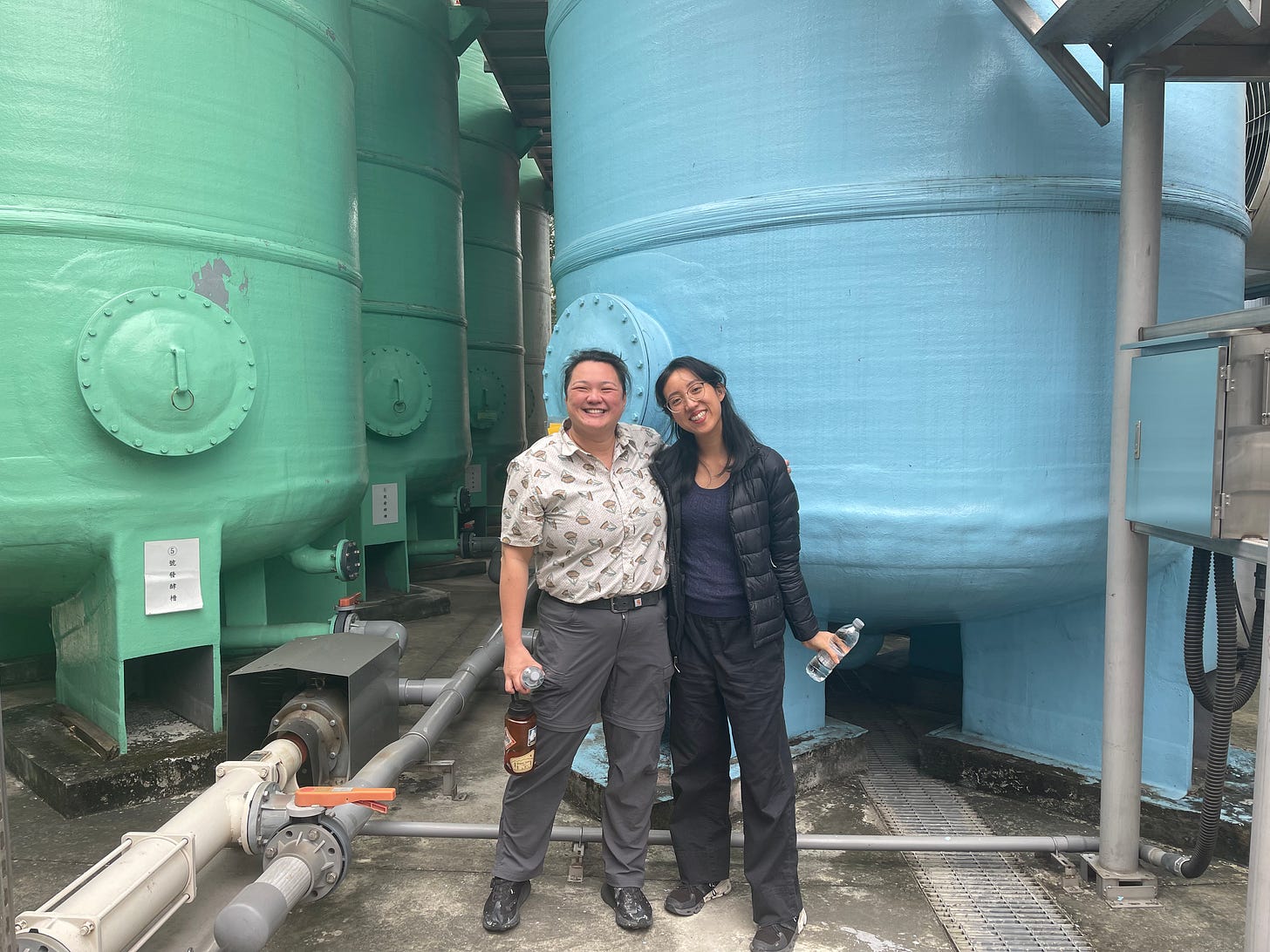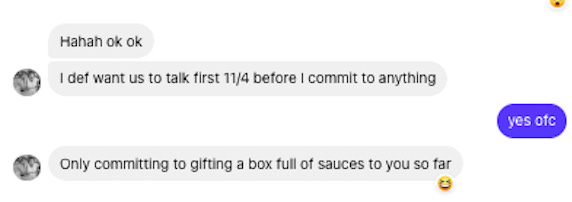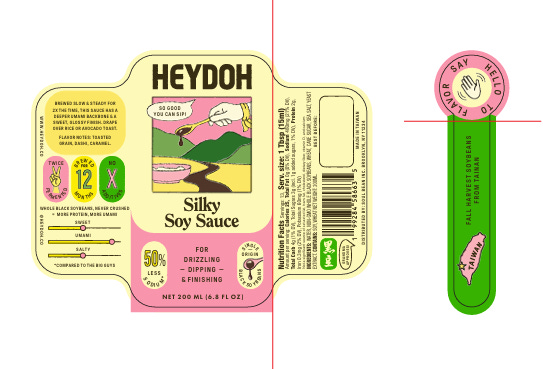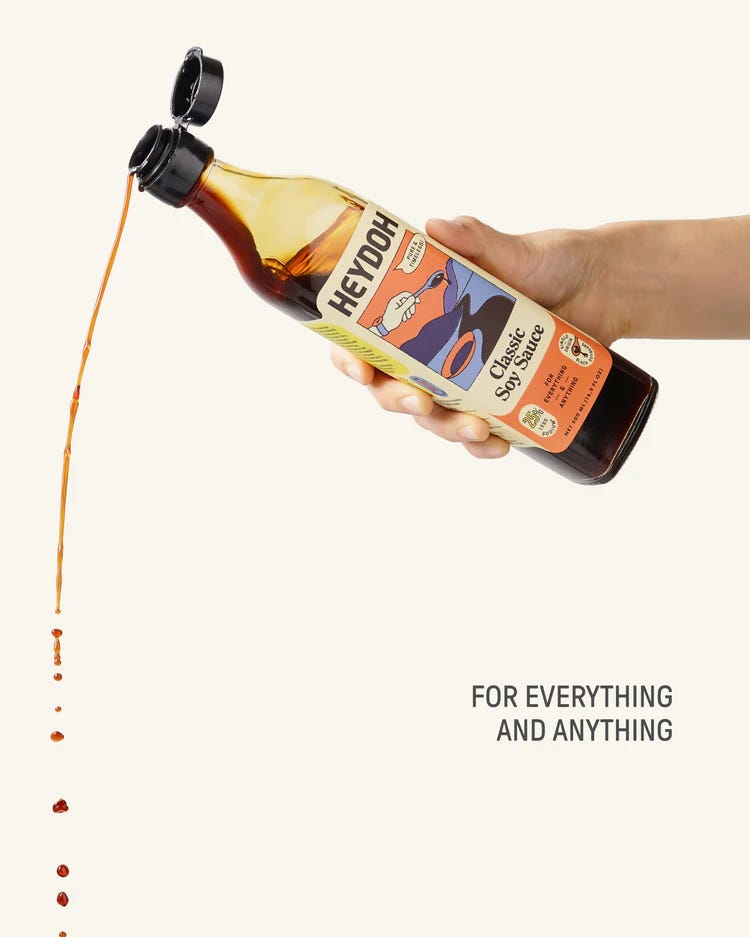How we built a soy sauce company
Part 2
This is the second installment in my series documenting my very, very nascent journey of starting a CPG (consumer packaged goods) business. You can read Part 1 here.
Transitioning from writing to business was a deep learning curve, but also surprisingly more intuitive than I thought it would be. Freelance writers are already small enterprises in motion, constantly pitching, negotiating, and packaging our ideas for the world. Friends in CPG warned me about the notoriously thin margins in selling food. But then I showed them the numbers behind freelance journalism and cookbook publishing, and they immediately gave me their blessing. My financial expectations were already modest. “You’ll be fine,” they said.
Last week in Part 1, I talked about why I wanted to sell soy sauce. In today’s post, I’ll break down how I got started:
1) Assembled a team
I always knew the first step was to build the right team. I’m a storyteller by trade, and though I have a pre-existing audience and had settled on a product with a strong market fit, I had no idea how to build a financial forecast, how to calculate COGS (cost of goods sold), or or do anything in Excel beyond basic addition.
So I did what I always do when I’m staring at a blank page: I started talking to anyone who would listen. I wanted to see who resonated and who felt the same itch. It took about five months to find the right people and the right dynamic. But once I did, everything snapped into place.
A bit about my team:
Our Chief Product Officer Hank Hsieh is one of the most efficient people I’ve ever worked with. We call him our supplier whisperer. Born and raised in Taiwan and trained as an engineer, he brings structure to everything we do. Though I’ve lived in Taiwan for years, I’m still seen as slightly outside the fold given my accent and American mannerisms. Hank smooths that over instantly.
Still, having two people based in Taiwan wasn’t going to help us much. I knew I only wanted to sell to the American market, and so I needed someone in the States to handle logistics and operations and ideally, all the math.
Enter Christine Liu, my co-founder and our COO/CTO, the yang to my yin. When she signed on, soy sauce finally stopped being a vague idea and became an actual company. Christine is based in New York City, is a data engineer from big tech, worked at a supply chain start-up, and is extremely good at digesting numbers and building systems. We are childhood friends and had spent a significant amount of timing traveling rural China together in our 20s, so I knew we could get along in dicey situations. In many ways, we are complete opposites. I’m introverted. She’s extroverted. I know my way around words. She knows her way around numbers.
I knew she was in between jobs, and I had been coyly pitching soy sauce to her online for weeks, though she kept shrugging it off. Understandably so. It wasn’t the obvious career move for her.
But then last fall she came to Taiwan on vacation and brought a box of trendy sauces from the States for me to do some market research with. Hank and I took her to one of the soy sauce factories we had been in touch with, she tasted the sauce, and was sold on the spot. We ended up spending the rest of her vacation writing up our business plan, lining up advisors, and hunting down the perfect glass bottle between hot pot meals.
Suddenly, the pace went from slow and uncertain to fast and electric. That’s how you know: when everyone in your team is self-motivated, knows exactly what role they’re playing in the company, and the to-do lists start to generate themselves.
2) Hired a lawyer
These days, you can use LegalZoom and create a company in a couple hours. We considered it. But a close friend of mine had done exactly that for her tech startup a couple months prior, made a few glaring mistakes in the paperwork, and later had to bring in a major law firm to sort everything out once they raised money. Her advice was to get it right from the start.
She mentioned that a high school friend of ours was now a startup lawyer at Russ August & Kabat. We hopped on call with her, she listened to what we wanted to build, and incorporated us. While hiring a law firm ate up most of the money we had in those early months, it was completely worth it. Now that we’re growing and fielding interest from investors, we don’t have to worry about our cap table (company’s equity ownership) or paperwork being a mess. Everything is clean, which is exactly what investors want to see.
3) Negotiated and secured production and suppliers
Honestly, this was the easiest part and where my background as a champion of Taiwanese food and stories played the most to our advantage. I’ve had Taiwanese media write about my work over the years, and having local Chinese-language press clips helped build a strong case for why people should work with me. At one point, a supplier even insinuated that the Taiwanese government should be paying me to promote Taiwanese food to the Western world (hah!).
Our team dynamic helped a lot as well. All three of us are Taiwanese and speak Chinese (so they trust and understand us and vice versa). Christine and I are Americans (so they saw potential in us in expanding their market outside of Taiwan). Christine and Hank are engineers (people love that). Christine has an Ivy League education (you’d be surprised how much people love that even more than anything else listed above).
I won’t and can’t go too much into the nitty gritty here, but I will say that there is immense value in being invested in and based where your suppliers are. We don’t parachute source and we’re proud of it.
4) Invested our own money and convinced our family and friends
Obviously, we needed money. So we put in a lot of our own savings and rallied together some friends and family to help us get through our first production run. Our lawyer suggested fundraising via SAFE, which is a quick way to raise money without expensive paperwork, additional legal fees, and diluting our cap table early on. This was also a good exercise in seeing if we had landed on a good product and messaging. Most of the friends we approached were sold at first sip, and within three months of us incorporating our company, we had raised enough to place our first production order, partner with a logistics company, hire a branding studio, and pay all the legal fees. All of our investors during this first round were first-degree connections and that was important to us. We wanted people who believed in us and the product, not institutional capital pushing for a growth pace that didn’t make sense for where we were.
5) Branding
This was the most difficult and most rewarding part of the process, and something I’ll dive in deeper for next week, but branding was a six month long process of trial and error, us trying to cheap out by doing as much of it ourselves, and me going insane on Pinterest. In short, we ended up losing money on designs we didn’t like at all.
Eventually, we bit the bullet, and decided we were going to invest a significant part of the money we had on a proper American branding studio (context: we were quoted a range of $10k-$50k USD for packaging design). We interviewed at least seven very reputable places, and after narrowing them down by price point, we settled on Herefor Studio…mostly because we just really trusted and vibed with the team. Perhaps that’s a strange way to choose a design studio, but that’s been the resounding strategy that Christine and I have used whenever we decide to partner with people. Do we get along with them? Are they actually enthused about our product or just looking to make a quick buck? Are they condescending or do they seem bored? Is it easy to communicate with them? Herefor passed with flying colors, and we love the final design they put together for us.
6) Asked for help along the way
Though Christine, Hank, and I are all fairly accomplished in our respective fields, none of us had started a CPG brand before. We knew we needed people who had actually taken a shelf-stable product to market. So we brought on my friends Jane and Denner from Empress Hot Sauce as advisors. They guided us through everything from supply chain negotiations and pricing structures to logistics and supplier introductions. Having them to call whenever we hit a snag has saved us countless mistakes and a lot of money. Quick plug: If you’re thinking about developing a CPG brand that sources from Taiwan, Jane and Denner are available for hire as consultants. I can’t recommend them enough. In one of our early meetings, they had Christine and me sit down and map out our five- and ten-year plan. Those goals have shifted since launch, of course, but having advisors who’ve actually done this before and can help us zoom out and see the industry from a wider perspective has been invaluable.
Obviously, this is a very condensed summary of all that we went through the last year to bring the product to market. Next week, I’ll dive deeper into the branding process.




